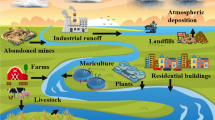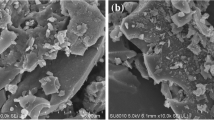Abstract
Biopolymer-based magnetic beads, composed of kappa-carrageenan (κ-Car) and Fe3O4 nanoparticles, were synthesized. The magnetic beads were prepared through in situ precipitation of Fe2+/Fe3+ ions in the presence of carrageenan and subsequently treating with K+ solution. The structure of magnetic kappa-carrageenan beads (mκ-Carb) was characterized by scanning electron microscopy (SEM), transmission electron microscopy (TEM), vibrating sample magnetometer, and thermal gravimetric analysis techniques. According to SEM micrographs, an undulant and coarse structure with cubic-shaped sections was obtained when the magnetic nanoparticles were incorporated in composition of beads. The TEM image confirmed the formation of magnetic nanoparticles with an average size of 3–7 nm. The synthesized beads were examined as adsorbent to remove crystal violet dye from aqueous solutions. It was found that due to coarse surface, the rate of dye adsorption on magnetic beads can be improved slightly. The experimental adsorption kinetics was analyzed according to pseudo-first-order and pseudo-second-order kinetic models and the adsorption kinetics followed well the pseudo-second-order model. Isotherm adsorption data of dye on beads were modeled according to Langmuir and Freundlich isotherm models. The results revealed that the experimental data have the best fit to Langmuir isotherm model, and maximum adsorption capacity of beads for dye obtained was 84.7 mg/g. The influence of pH on the variation of adsorption capacity of beads for crystal violet was not considerable. The thermodynamic parameters indicated that the adsorption of CV dye on beads is spontaneous.






Similar content being viewed by others
References
Kirk RE, Othmer DF (1992) Encyclopedia of chemical technology. In: Kroschwitz I, Howe-Grant M (eds), 4th edn, vol. 4, Wiley, New York, pp 942–961
Usov AI (1998) Structural analysis of red seaweed galactans of agar and carrageenan groups. Food Hydrocoll 12:301–308
Theerkeelsen HG (1993) Industrial gums: carrageenan chapter. In: Whistler RL, BeMiller JN (eds), Academic Press, London
Li L, Ni R, Shao Y, Mao S (2014) Carrageenan and its application in drug delivery. Carbohydr Polym 103:1–11
Morris ER, Rees DA, Robinson G (1980) Cation-specific aggregation of carrageenan helices: domain model of polymer gel structure. J Mol Biol 138:349–362
Rodrigues S, Ros-da-Costa AM, Grenha A (2012) Chitosan/carrageenan nanoparticles: effect of cross-linking with tripolyphosphate and charge ratios. Carbohydr Polym 89:282–289
Mohamadnia Z, Zohuriaan-Mehr MJ, Kabiri K, Jamshidi A, Mobedi H (2007) pH-Sensitive IPN hydrogel beads of carrageenan-alginate for controlled drug delivery. J Bioact Compat Polym 22:342–356
Mitsumata T, Sakai K, Takimoto J (2006) Giant reduction in dynamic modulus of kappa-carrageenan magnetic gels. J Phys Chem B 110:20217–20223
Sagbas S, Butun S, Sahiner N (2012) Modifiable chemically crosslinked poli(κ-carrageenan) particles. Carbohydr Polym 87:2718–2724
Muhamad II, Fen LS, Hui NH, Mustapha NA (2011) Genipin-cross-linked kappa-carrageenan/carboxymethyl cellulose beads and effects on beta-carotene release. Carbohydr Polym 83:1207–1212
Tranquilan-Aranilla C, Nagasawa N, Bayquen A, Rosa AD (2012) Synthesis and characterization of carboxymethyl derivatives of kappa-carrageenan. Carbohydr Polym 87:1810–1816
Zu J, Shi F, Liu R, Ye M (2013) Amination of glycidyl methacrylate-grafted polystyrene particles and their adsorption capacity for Nd3+ and Cd2+. Iran Polym J 22:259–265
Sui K, Li Y, Liu R, Zhang Y, Zhao X, Liang H, Xia Y (2012) Biocomposite fiber of calcium alginate/multi-walled carbon nanotubes with enhanced adsorption properties for ionic dyes. Carbohydr Polym 90:399–406
Li G, Du Y, Tao Y, Deng H, Luo X, Yang J (2010) Iron(II) cross-linked chitin-based gel beads: preparation, magnetic property and adsorption of methyl orange. Carbohydr Polym 82:706–713
Wan Ngah WS, Teong LC, Hanafiah MAKM (2011) Adsorption of dyes and heavy metal ions by chitosan composites: a review. Carbohydr Polym 83:1446–1456
Sayar F, Guven G, Piskin E (2006) Magnetically loaded poly(methyl methacrylate-co-acrylic acid) nanoparticles. Colloid Polym Sci 284:965–978
Bruce IJ, Sen T (2005) Surface modification of magnetic nanoparticles with alkoxysilanes and their application in magnetic bioseparations. Langmuir 21:7029–7035
Starodubtsev SG, Saenko EV, Dokukin ME, Aksenov VL, Klechkovskaya VV, Zanaveskina IS (2005) Formation of magnetite nanoparticles in poly(acrylamide) gels. J Phys Condens Matter 17:1471–1480
Philippova O, Barabanova A, Molchanov V, Khokhlov A (2011) Magnetic polymer beads: recent trends and developments in synthetic design and applications. Eur Polym J 47:542–559
Liu P, Zhang L (2007) Adsorption of dyes from aqueous solutions or suspensions with clay nano-adsorbents. Sep Purif Technol 58:32–39
Dai J, Yang H, Yan H, Shangguan Y, Zheng Q, Cheng R (2011) Phosphate adsorption from aqueous solutions by disused adsorbents: chitosan hydrogel beads after the removal of copper (II). Chem Eng J 166:970–977
Shah A, Khuhawar MY, Shah SA (2012) Evaluation of sorption behavior of polymethylene-bis(2-hydroxybenzaldehyde) for Cu(II), Ni(II), Fe(III), Co(II) and Cd(II) ions. Iran Polym J 21:325–334
Li S (2010) Removal of crystal violet from aqueous solution by sorption into semi-interpenetrated networks hydrogels constituted of poly(acrylic acid-acrylamide-methacrylate) and amylose. Bioresour Technol 101:2197–2202
Singh KP, Gupta S, Singh AK, Sinha S (2011) Optimizing adsorption of crystal violet dye from water by magnetic nanocomposite using response surface modeling approach. J Hazard Mater 186:1462–1573
Nandi BK, Goswami A, Das AK, Mondal B, Purkait MK (2008) Kinetic and equilibrium studies on the adsorption of crystal violet dye using kaolin as an adsorbent. Sep Sci Technol 43:1382–1403
Mall ID, Srivastava VC, Agarwal NK (2006) Removal of orange-G and methyl violet dyes by adsorption onto bagasse fly ash—kinetic study and equilibrium isotherm analyses. Dyes Pigment 69:210–223
Mahdavinia GR, Aghaie H, Sheykhloie H, Vardini MT, Etemadi H (2013) Synthesis of CarAlg/MMt nanocomposite hydrogels and adsorption of cationic crystal violet. Carbohydr Polym 98:358–365
Li P, Siddaramaiah Kim NH, Heo SB, Lee JH (2008) Novel PAAm/laponite clay nanocomposite hydrogels with improved cationic dye adsorption behavior. Compos Part B 39:756–763
Mahdavinia GR, Massoudi A, Baghban A, Massoumi B (2012) Novel carrageenan-based hydrogel nanocomposites containing laponite RD and their application to remove cationic dye. Iran Polym J 21:609–619
Auta M, Hameed BH (2011) Preparation of waste tea activated carbon using potassium acetate as an activating agent for adsorption acid blue 25 dye. Chem Eng J 171:502–509
Nabid MR, Sedghi R, Sharifi R, Abdi-Oskooie H, Heravi MM (2013) Removal of toxic nitrate ions from drinking water using conducting polymer/MWCNTs nanocomposites. Iran Polym J 22:85–92
Peppas LB, Harland RS (1990) Absorbent polymer technology. Elsevier, Amsterdam, pp 45–66
Al-Degs YS, El-Barghouthi MI, El-Sheikh AH, Walker GM (2008) Effect of solution pH, ionic strength, and temperature on adsorption behavior of reactive dyes on activated carbon. Dyes Pigment 77:16–23
Durmaz S, Okay O (2000) Acrylamide/2-acrylamido-2-methylpropane sulfonic acid sodium salt-based hydrogels: synthesis and characterization. Polymer 41:3693–3704
Liu Y (2009) Is the free energy change of adsorption correctly calculated? J Chem Eng Data 54:1981–1985
Author information
Authors and Affiliations
Corresponding author
Rights and permissions
About this article
Cite this article
Mahdavinia, G.R., Iravani, S., Zoroufi, S. et al. Magnetic and K+-cross-linked kappa-carrageenan nanocomposite beads and adsorption of crystal violet. Iran Polym J 23, 335–344 (2014). https://doi.org/10.1007/s13726-014-0229-8
Received:
Accepted:
Published:
Issue Date:
DOI: https://doi.org/10.1007/s13726-014-0229-8




